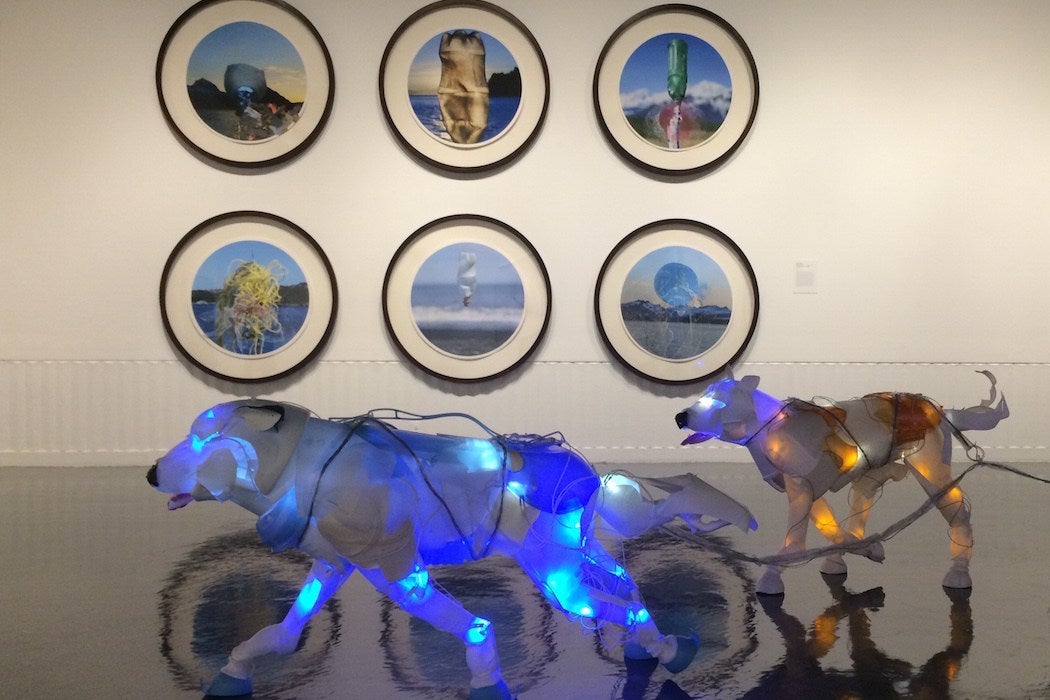Earlier this month, Google Maps added a special feature for coastal Los Angeles: predictive maps illustrating the effects of global warming on different neighborhoods throughout the city. This same month, USC’s Fisher Museum opened two simultaneous exhibits (GYRE: The Plastic Ocean and Cynthia Minet’s Beast of Burden) showcasing environmentally-themed art focusing specifically on the dangers of plastic on the environment.
These exhibits offer a range of events for visitors, students, and families, enabling them to interact with the art while learning about the environment. Eco-visualizations, such as Google’s effort, Eco-art, and environmental museum exhibitions, have made environmental data and science more accessible through visual illustrations. In other words, we might learn about the data, but it becomes much easier to process once it has been translated visually.
Artist Tiffany Holmes explores how such visualizations help make the data more meaningful. “Eco-visualization technology offers a new way to dynamically picture environmental data and makes it meaningful to a museum population.” In this sense, she argues, artists become translators.
Holmes looks at early experiments with Eco-art from the 1960s to the 1980s and considers the various strategies artists implemented, including, “real-time clean up, outdoor performances, community engagement, scientific collaboration, and perhaps most importantly, public education.”
In “Teaching Systems Thinking and Practice through Environmental Art,” Ann T. Rosenthal asserts that Eco-art is necessarily multidisciplinary and pedagogical. She also finds it useful to teach in school, as students are expected to translate the data into knowledge, thereby developing a better grasp of the material.
Teaching Eco-art provides a highly effective framework to integrate and re-synthesize knowledge, through discussion of critical texts drawn from diverse fields, and production of collaborative, multidisciplinary projects–balancing theory and practice.
Cynthia Minet’s work, featured in both GYRE and her solo show, considers environmental art and its pedagogical role both inside and outside of the museum. She creates large animal sculptures from found and reused plastic. She cuts, carves, and connects the pieces of detergent bottles, plastic caps, dismantled children’s swimming pools, and disposable contact lens cases to create life-size plastic imitations of nature. Using an intricately devised internal system of wires and LED lights, Minet illuminates her sculptures from the inside with soft pastel colors and white lights that make her pieces beautiful. And yet, there is also a sense of eerie foreboding: a silent warning that plastic may one day come to replace these very animals.
Weekly Digest
Other artists have also incorporated found plastic in their art in different and innovative ways. Andy Hughes manipulates and photographs plastic to take on alien-like forms within the environment, while Steve McPherson spins narrative tales about abandoned plastic, labeling each piece as if it’s a scientific specimen.
Alongside the art, museums allow for additional information such as infographics, timelines, and scientific summaries that further enliven the educational experience. While viewing McPherson’s plastic debris, for example, visitors also learn about breakdown rates, which is the estimated amount of time it takes materials to decompose naturally. (A plastic bag is estimated at 10-20 years, while a plastic bottle is estimated at 450 years.)
In this sense, environmental art is an urgent call to action: visitors hopefully will be moved enough to both learn and change habits in order to decrease their environmental footprint(s) on earth. Reactions to Eco-art are often complicated, comprised of a juxtaposition of feelings — aesthetically pleasing, depressing, instructive, foreboding, compelling, informative, deeply moving, and hopefully deeply motivating.







